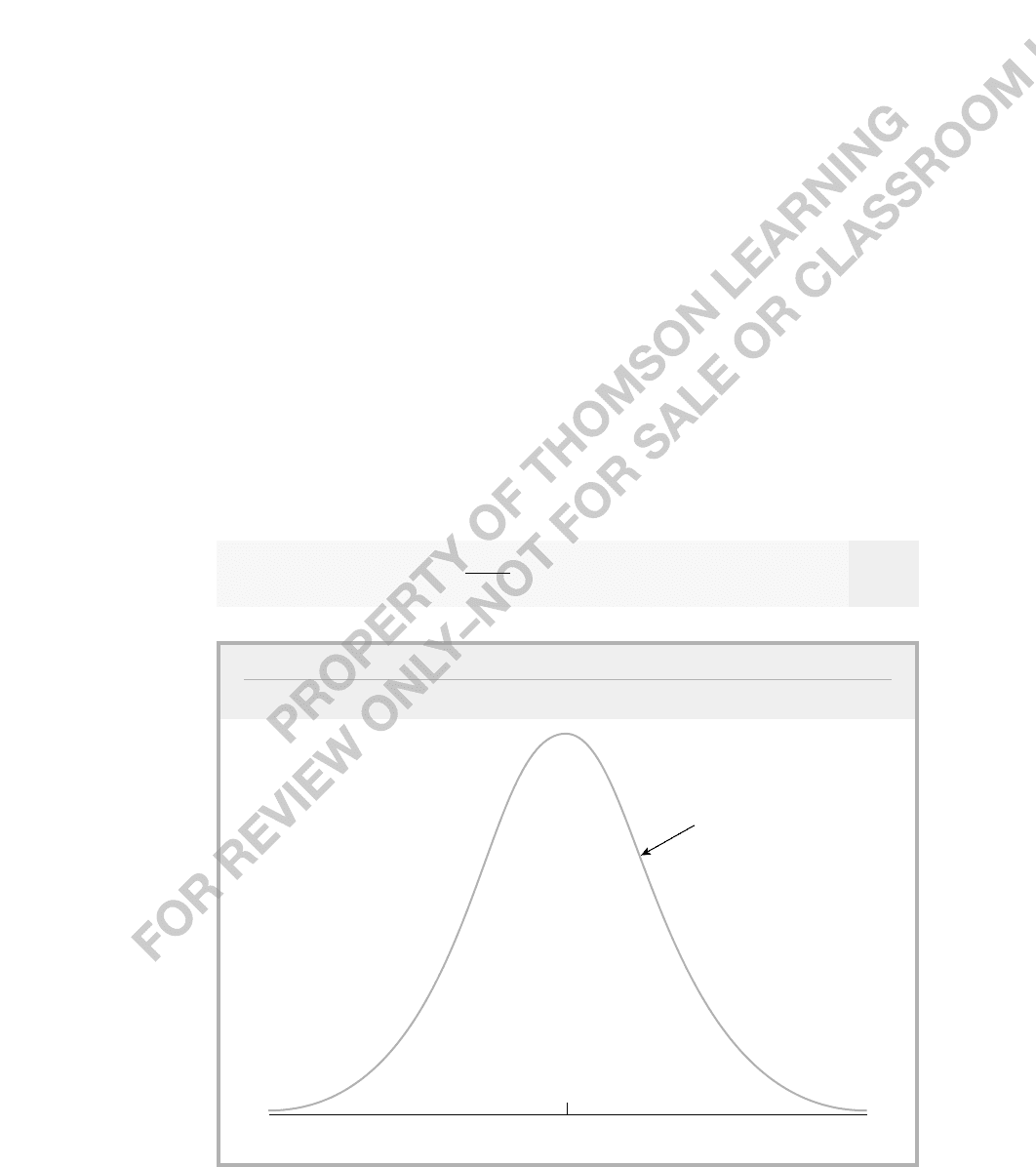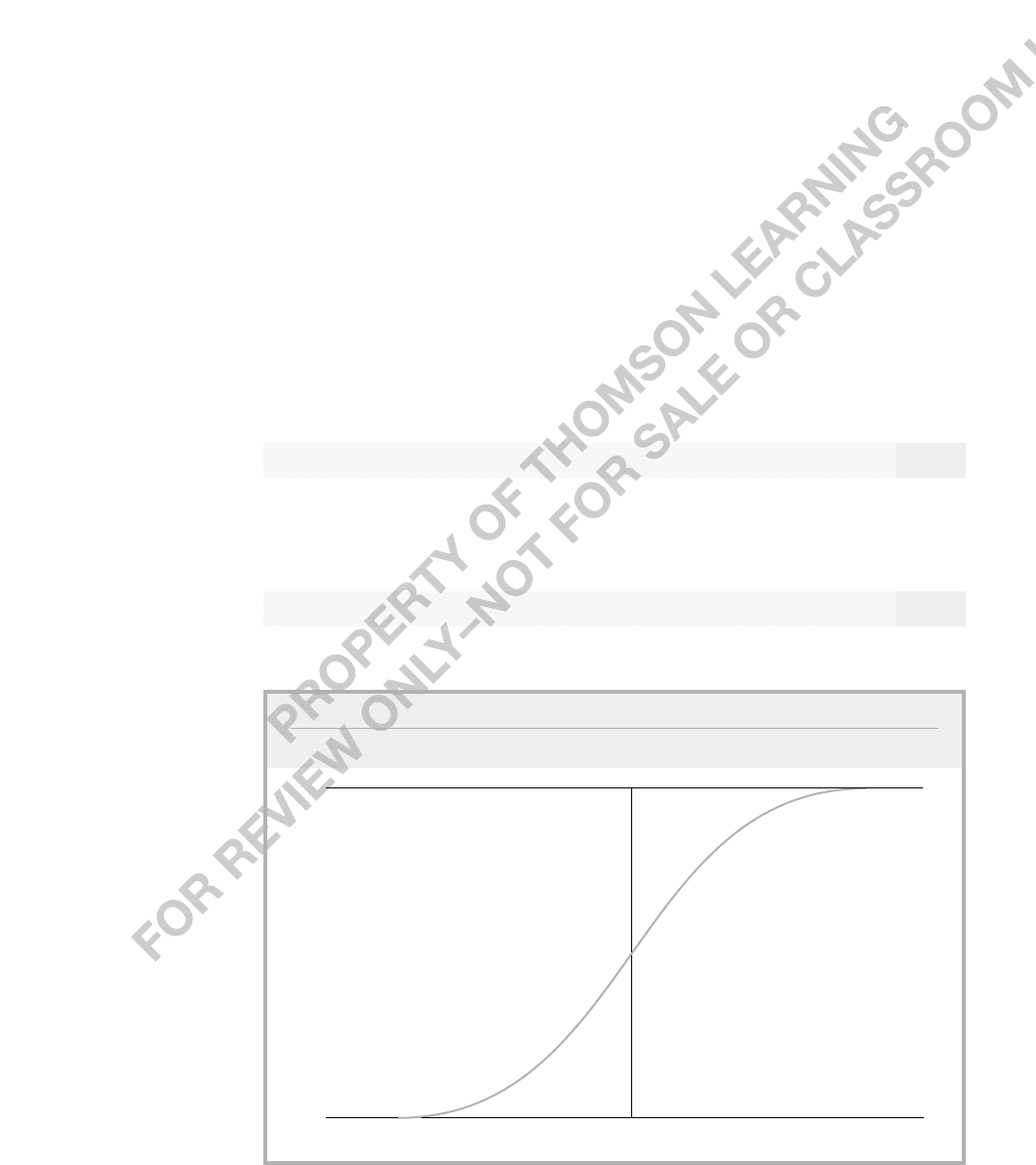Wooldridge J. Introductory Econometrics: A Modern Approach (Basic Text - 3d ed.)
Подождите немного. Документ загружается.


PROPERTY COV.2
For any constants a
1
, b
1
, a
2
, and b
2
,
Cov(a
1
X b
1
,a
2
Y b
2
) a
1
a
2
Cov(X,Y).
(B.28)
An important implication of COV.2 is that the covariance between two random variables
can be altered simply by multiplying one or both of the random variables by a constant.
This is important in economics because monetary variables, inflation rates, and so on can
be defined with different units of measurement without changing their meaning.
Finally, it is useful to know that the absolute value of the covariance between any two
random variables is bounded by the product of their standard deviations; this is known as
the Cauchy-Schwartz inequality.
PROPERTY COV.3
Cov(X,Y) sd(X)sd(Y).
Correlation Coefficient
Suppose we want to know the relationship between amount of education and annual earn-
ings in the working population. We could let X denote education and Y denote earnings and
then compute their covariance. But the answer we get will depend on how we choose to
measure education and earnings. Property COV.2 implies that the covariance between
education and earnings depends on whether earnings are measured in dollars or thousands
of dollars, or whether education is measured in months or years. It is pretty clear that
how we measure these variables has no bearing on how strongly they are related. But the
covariance between them does depend on the units of measurement.
The fact that the covariance depends on units of measurement is a deficiency that is
overcome by the correlation coefficient between X and Y:
Corr(X,Y) ;
(B.29)
the correlation coefficient between X and Y is sometimes denoted r
XY
(and is sometimes
called the population correlation).
Because s
X
and s
Y
are positive, Cov(X,Y) and Corr(X,Y) always have the same sign,
and Corr(X,Y) 0 if, and only if, Cov(X,Y) 0. Some of the properties of covariance
carry over to correlation. If X and Y are independent, then Corr(X,Y) 0, but zero corre-
lation does not imply independence. (Like the covariance, the correlation coefficient is
also a measure of linear dependence.) However, the magnitude of the correlation coeffi-
cient is easier to interpret than the size of the covariance due to the following property.
PROPERTY CORR.1
1 Corr(X,Y) 1.
If Corr(X,Y) 0, or equivalently Cov(X,Y) 0, then there is no linear relationship
between X and Y, and X and Y are said to be uncorrelated random variables; otherwise,
s
XY
s
X
s
Y
Cov(X,Y)
sd(X)sd(Y)
746 Appendix B Fundamentals of Probability

X and Y are correlated. Corr(X,Y) 1 implies a perfect positive linear relationship, which
means that we can write Y a bX for some constant a and some constant b 0.
Corr(X,Y) 1 implies a perfect negative linear relationship, so that Y a bX for
some b 0. The extreme cases of positive or negative 1 rarely occur. Values of r
XY
closer
to 1 or 1 indicate stronger linear relationships.
As mentioned earlier, the correlation between X and Y is invariant to the units of
measurement of either X or Y. This is stated more generally as follows.
PROPERTY CORR.2
For constants a
1
, b
1
, a
2
, and b
2
, with a
1
a
2
0,
Corr(a
1
X b
1
,a
2
Y b
2
) Corr(X,Y).
If a
1
a
2
0, then
Corr(a
1
X b
1
,a
2
Y b
2
) Corr(X,Y).
As an example, suppose that the correlation between earnings and education in the work-
ing population is .15. This measure does not depend on whether earnings are measured in
dollars, thousands of dollars, or any other unit; it also does not depend on whether
education is measured in years, quarters, months, and so on.
Variance of Sums of Random Variables
Now that we have defined covariance and correlation, we can complete our list of major
properties of the variance.
PROPERTY VAR.3
For constants a and b,
Var(aX bY) a
2
Var(X) b
2
Var(Y) 2abCov(X,Y).
It follows immediately that, if X and Y are uncorrelated—so that Cov(X,Y) 0—then
Var(X Y) Var(X) Var(Y)
(B.30)
and
Var(X Y) Var(X) Var(Y).
(B.31)
In the latter case, note how the variance of the difference is the sum of the variances, not
the difference in the variances.
As an example of (B.30), let X denote profits earned by a restaurant during a Friday
night and let Y be profits earned on the following Saturday night. Then, Z X Y is
profits for the two nights. Suppose X and Y each have an expected value of $300 and a
standard deviation of $15 (so that the variance is 225). Expected profits for the two nights
is E(Z) E(X) E(Y) 2(300) 600 dollars. If X and Y are independent, and therefore
Appendix B Fundamentals of Probability 747

uncorrelated, then the variance of total profits is the sum of the variances: Var(Z)
Var(X) Var(Y) 2(225) 450. It follows that the standard deviation of total profits
is
450 or about $21.21.
Expressions (B.30) and (B.31) extend to more than two random variables. To state this
extension, we need a definition. The random variables {X
1
,…,X
n
} are pairwise uncor-
related random variables if each variable in the set is uncorrelated with every other vari-
able in the set. That is, Cov(X
i
,X
j
) 0, for all i j.
PROPERTY VAR.4
If {X
1
,…,X
n
} are pairwise uncorrelated random variables and {a
i
: i 1, …, n} are con-
stants, then
Var(a
1
X
1
… a
n
X
n
) a
2
1
Var(X
1
) … a
2
n
Var(X
n
).
In summation notation, we can write
Var
Q
n
i1
a
i
X
i
R
n
i1
a
i
2
Var(X
i
).
(B.32)
A special case of Property VAR.4 occurs when we take a
i
1 for all i. Then, for pair-
wise uncorrelated random variables, the variance of the sum is the sum of the variances:
Var
Q
n
i1
X
i
R
n
i1
Var(X
i
).
(B.33)
Because independent random variables are uncorrelated (see Property COV.1), the vari-
ance of a sum of independent random variables is the sum of the variances.
If the X
i
are not pairwise uncorrelated, then the expression for Var
Q
n
i1
a
i
X
i
R
is much
more complicated; we must add to the right-hand side of (B.32) the terms 2a
i
a
j
Cov(x
i
,x
j
)
for all i j.
We can use (B.33) to derive the variance for a binomial random variable. Let X ~
Binomial(n,u) and write X Y
1
… Y
n
,where the Y
i
are independent Bernoulli(u)
random variables. Then, by (B.33), Var(X) Var(Y
1
) … Var(Y
n
) nu(1 u).
In the airline reservation example with n 120 and u .85, the variance of the num-
ber of passengers arriving for their reservations is 120(.85)(.15) 15.3, so the standard
deviation is about 3.9.
Conditional Expectation
Covariance and correlation measure the linear relationship between two random variables
and treat them symmetrically. More often in the social sciences, we would like to explain
one variable, called Y, in terms of another variable, say, X. Further, if Y is related to X in a
nonlinear fashion, we would like to know this. Call Y the explained variable and X the ex-
planatory variable. For example, Y might be hourly wage, and X might be years of formal
education.
748 Appendix B Fundamentals of Probability

We have already introduced the notion of the conditional probability density function
of Y given X. Thus, we might want to see how the distribution of wages changes with edu-
cation level. However, we usually want to have a simple way of summarizing this distri-
bution. A single number will no longer suffice, since the distribution of Y given X x
generally depends on the value of x. Nevertheless, we can summarize the relationship
between Y and X by looking at the conditional expectation of Y given X, sometimes called
the conditional mean. The idea is this. Suppose we know that X has taken on a particular
value, say, x. Then, we can compute the expected value of Y,given that we know this out-
come of X. We denote this expected value by E(YX x), or sometimes E(Yx) for short-
hand. Generally, as x changes, so does E(Yx).
When Y is a discrete random variable taking on values {y
1
,…,y
m
}, then
E(Yx)
m
j1
y
j
f
YX
(y
j
x).
When Y is continuous, E(Yx) is defined by integrating yf
YX
(yx) over all possible values
of y. As with unconditional expectations, the conditional expectation is a weighted aver-
age of possible values of Y,but now the weights reflect the fact that X has taken on a spe-
cific value. Thus, E(Yx) is just some function of x,which tells us how the expected value
of Y varies with x.
As an example, let (X,Y) represent the population of all working individuals, where
X is years of education and Y is hourly wage. Then, E(YX 12) is the average hourly
wage for all people in the population with 12 years of education (roughly a high
school education). E(YX 16) is the average hourly wage for all people with 16 years
of education. Tracing out the expected value for various levels of education provides
important information on how wages and education are related. See Figure B.5 for an
illustration.
In principle, the expected value of hourly wage can be found at each level of educa-
tion, and these expectations can be summarized in a table. Because education can vary
widely—and can even be measured in fractions of a year—this is a cumbersome way to
show the relationship between average wage and amount of education. In econometrics,
we typically specify simple functions that capture this relationship. As an example,
suppose that the expected value of WAGE given EDUC is the linear function
E(WAGEEDUC) 1.05 .45 EDUC.
If this relationship holds in the population of working people, the average wage for peo-
ple with 8 years of education is 1.05 .45(8) 4.65, or $4.65. The average wage for
people with 16 years of education is 8.25, or $8.25. The coefficient on EDUC implies that
each year of education increases the expected hourly wage by .45, or 45 cents.
Conditional expectations can also be nonlinear functions. For example, suppose that
E(Yx) 10/x,where X is a random variable that is always greater than zero. This function
is graphed in Figure B.6. This could represent a demand function, where Y is quantity
demanded and X is price. If Y and X are related in this way, an analysis of linear associ-
ation, such as correlation analysis, would be incomplete.
Appendix B Fundamentals of Probability 749

Properties of Conditional Expectation
Several basic properties of conditional expectations are useful for derivations in econo-
metric analysis.
PROPERTY CE.1
E[c(X)X] c(X), for any function c(X).
This first property means that functions of X behave as constants when we compute expec-
tations conditional on X. For example, E(X
2
X) X
2
. Intuitively, this simply means that
if we know X, then we also know X
2
.
PROPERTY CE.2
For functions a(X) and b(X),
E[a(X)Y b(X)X] a(X)E(YX) b(X).
For example, we can easily compute the conditional expectation of a function such as
XY 2X
2
:E(XY 2X
2
X) XE(YX) 2X
2
.
750 Appendix B Fundamentals of Probability
4 812
E(WAGE|EDUC)
16 20
EDUC
FIGURE B.5
The expected value of hourly wage given various levels of education.

The next property ties together the notions of independence and conditional
expectations.
PROPERTY CE.3
If X and Y are independent, then E(YX) E(Y).
This property means that, if X and Y are independent, then the expected value of Y given
X does not depend on X, in which case, E(YX) always equals the (unconditional)
expected value of Y. In the wage and education example, if wages were independent of
education, then the average wages of high school and college graduates would be the same.
Since this is almost certainly false, we cannot assume that wage and education are
independent.
A special case of Property CE.3 is the following: if U and X are independent and
E(U) 0, then E(UX) 0.
There are also properties of the conditional expectation that have to do with the fact
that E(YX) is a function of X,say,E(YX) m(X). Because X is a random variable, m(X)
is also a random variable. Furthermore, m(X) has a probability distribution and therefore
an expected value. Generally, the expected value of m(X) could be very difficult to com-
pute directly. The law of iterated expectations says that the expected value of m(X) is
simply equal to the expected value of Y. We write this as follows.
Appendix B Fundamentals of Probability 751
1 5 10
1
2
E(Y|x) 10
E(Y|x) = 10/x
x
FIGURE B.6
Graph of E(Yx) 10/x.

PROPERTY CE.4
E[E(YX)] E(Y).
This property is a little hard to grasp at first. It means that, if we first obtain E(YX) as a
function of X and take the expected value of this (with respect to the distribution of X,of
course), then we end up with E(Y). This is hardly obvious, but it can be derived using the
definition of expected values.
As an example of how to use Property CE. 4, let Y WAGE and X EDUC,where
WAGE is measured in hours and EDUC is measured in years. Suppose the expected value
of WAGE given EDUC is E(WAGEEDUC) 4 .60 EDUC. Further, E(EDUC) 11.5.
Then, the law of iterated expectations implies that E(WAGE) E(4 .60 EDUC) 4
.60 E(EDUC) 4 .60(11.5) 10.90, or $10.90 an hour.
The next property states a more general version of the law of iterated expectations.
PROPERTY CE.4
E(YX) E[E(YX,Z)X].
In other words, we can find E(YX) in two steps. First, find E(YX,Z) for any other ran-
dom variable Z. Then, find the expected value of E(YX,Z), conditional on X.
PROPERTY CE.5
If E(YX) E(Y), then Cov(X,Y) 0 [and so Corr(X,Y) 0]. In fact, every function of
X is uncorrelated with Y.
This property means that, if knowledge of X does not change the expected value of Y, then
X and Y must be uncorrelated, which implies that if X and Y are correlated, then E(YX)
must depend on X. The converse of Property CE.5 is not true: if X and Y are uncorrelated,
E(YX) could still depend on X. For example, suppose Y X
2
. Then, E(YX) X
2
,which
is clearly a function of X. However, as we mentioned in our discussion of covariance and
correlation, it is possible that X and X
2
are uncorrelated. The conditional expectation
captures the nonlinear relationship between X and Y that correlation analysis would
miss entirely.
Properties CE.4 and CE.5 have two important implications: if U and X are random
variables such that E(UX) 0, then E(U) 0, and U and X are uncorrelated.
PROPERTY CE.6
If E(Y
2
) and E[g(X)
2
] for some function g, then E{[Y m(X)]
2
X}
E{[Y g(X)]
2
X} and E{[Y m(X)]
2
} E{[Y g(X)]
2
}.
Property CE.6 is very useful in predicting or forecasting contexts. The first inequality says
that, if we measure prediction inaccuracy as the expected squared prediction error,
conditional on X, then the conditional mean is better than any other function of X for
predicting Y. The conditional mean also minimizes the unconditional expected squared
prediction error.
752 Appendix B Fundamentals of Probability

Conditional Variance
Given random variables X and Y, the variance of Y, conditional on X x, is simply the
variance associated with the conditional distribution of Y,given X x: E{[Y E(Yx)]
2
x}.
The formula
Var(YX x) E(Y
2
x) [E(Yx)]
2
is often useful for calculations. Only occasionally will we have to compute a conditional
variance. But we will have to make assumptions about and manipulate conditional vari-
ances for certain topics in regression analysis.
As an example, let Y SAVING and X INCOME (both of these measured annually
for the population of all families). Suppose that Var(SAVINGINCOME) 400 .25
INCOME. This says that, as income increases, the variance in saving levels also increases.
It is important to see that the relationship between the variance of SAVING and INCOME
is totally separate from that between the expected value of SAVING and INCOME.
We state one useful property about the conditional variance.
PROPERTY CV.1
If X and Y are independent, then Var(YX) Var(Y).
This property is pretty clear, since the distribution of Y given X does not depend on X, and
Var(YX) is just one feature of this distribution.
B.5 The Normal and Related Distributions
The Normal Distribution
The normal distribution and those derived from it are the most widely used distributions in
statistics and econometrics. Assuming that random variables defined over populations are
normally distributed simplifies probability calculations. In addition, we will rely heavily on
the normal and related distributions to conduct inference in statistics and econometrics—
even when the underlying population is not necessarily normal. We must postpone the
details, but be assured that these distributions will arise many times throughout this text.
A normal random variable is a continuous random variable that can take on any value.
Its probability density function has the familiar bell shape graphed in Figure B.7.
Mathematically, the pdf of X can be written as
f(x) exp[(x m)
2
/2s
2
], x ,
(B.34)
where m E(X) and s
2
Var(X). We say that X has a normal distribution with expected
value m and variance s
2
,written as X ~ Normal(m,s
2
). Because the normal distribution is
symmetric about m, m is also the median of X. The normal distribution is sometimes called
the Gaussian distribution after the famous statistician C. F. Gauss.
1
s
2
p
Appendix B Fundamentals of Probability 753

Certain random variables appear to roughly follow a normal distribution. Human
heights and weights, test scores, and county unemployment rates have pdfs roughly the
shape in Figure B.7. Other distributions, such as income distributions, do not appear to
follow the normal probability function. In most countries, income is not symmetrically
distributed about any value; the distribution is skewed toward the upper tail. In some cases,
a variable can be transformed to achieve normality. A popular transformation is the natu-
ral log, which makes sense for positive random variables. If X is a positive random vari-
able, such as income, and Y log(X) has a normal distribution, then we say that X has a
lognormal distribution. It turns out that the lognormal distribution fits income distribution
pretty well in many countries. Other variables, such as prices of goods, appear to be well
described as lognormally distributed.
The Standard Normal Distribution
One special case of the normal distribution occurs when the mean is zero and the variance
(and, therefore, the standard deviation) is unity. If a random variable Z has a Normal(0,1)
distribution, then we say it has a standard normal distribution. The pdf of a standard nor-
mal random variable is denoted f(z); from (B.34), with m 0 and s
2
1, it is given by
f(z) exp(z
2
/2), z . (B.35)
1
2p
754 Appendix B Fundamentals of Probability
m
x
f
X
for a normal
random variable
FIGURE B.7
The general shape of the normal probability density function.

The standard normal cumulative distribution function is denoted (z) and is obtained
as the area under f, to the left of z; see Figure B.8. Recall that (z) P(Z z); because
Z is continuous, (z) P(Z z) as well.
No simple formula can be used to obtain the values of (z) [because (z) is the inte-
gral of the function in (B.35), and this intregral has no closed form]. Nevertheless, the val-
ues for (z) are easily tabulated; they are given for z between 3.1 and 3.1 in Table G.1
in Appendix G. For z 3.1, (z) is less than .001, and for z 3.1, (z) is greater than
.999. Most statistics and econometrics software packages include simple commands for
computing values of the standard normal cdf, so we can often avoid printed tables entirely
and obtain the probabilities for any value of z.
Using basic facts from probability—and, in particular, properties (B.7) and (B.8) con-
cerning cdfs—we can use the standard normal cdf for computing the probability of any
event involving a standard normal random variable. The most important formulas are
P(Z z) 1 (z),
(B.36)
P(Z z) P(Z z),
(B.37)
and
P(a Z b) (b) (a).
(B.38)
Appendix B Fundamentals of Probability 755
0
z
1
0
.5
3
3
FIGURE B.8
The standard normal cumulative distribution function.
